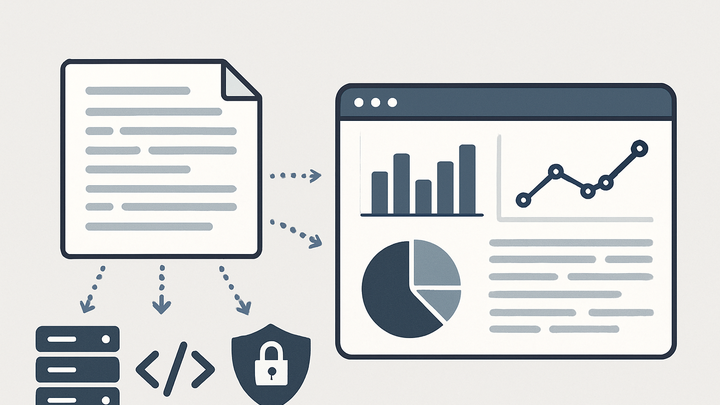Published on 2025-06-28T05:36:15Z
What is Log File Analysis? Examples with PlainSignal and GA4
Log File Analysis is a server-side analytics technique that processes raw web server logs to extract user behavior, performance, and security insights.
Unlike client-side tagging, it operates without JavaScript or cookies, ensuring resilience to ad blockers and privacy regulations. The process involves collecting log entries, parsing them into structured datasets, and aggregating metrics such as page views, error rates, and bot activity.
Platforms like PlainSignal (a cookie-free, server-driven solution) and GA4 (via Measurement Protocol ingestion) can utilize log file analysis to complement traditional analytics workflows. By inspecting every HTTP request recorded on the server, organizations gain a comprehensive, unfiltered view of site traffic and system performance.
Log file analysis
Server-side technique processing raw web logs to derive analytics insights without cookies or client scripts.
Overview of Log File Analysis
This section introduces the core concept of log file analysis, explaining what it is and why it matters in modern analytics.
-
Definition
Log file analysis is the process of collecting and examining raw, server-generated log entries to derive actionable insights about website usage, security events, and operational performance.
-
Key components
Effective log file analysis typically involves several stages, each crucial to transforming unstructured logs into meaningful metrics.
-
Log collection
Gathering raw log files from web servers, proxies, and APIs, often in formats like Apache or Nginx combined logs.
-
Log parsing
Converting unstructured log entries into structured records by extracting fields such as timestamp, IP address, request path, status code, and user agent.
-
Analysis & reporting
Aggregating parsed data into reports, dashboards, and alerts to monitor traffic trends, performance metrics, and anomalies.
-
Benefits and Use Cases
Explores the main advantages of log file analysis and where it is most commonly applied.
-
Privacy and compliance
Since it does not rely on cookies or client-side scripts, log file analysis aligns well with data protection regulations (e.g., GDPR) and respects user privacy.
-
Ad blocker resilience
Because it operates at the server level, it captures every HTTP request, even if a user has blocked JavaScript or tracking pixels.
-
Performance monitoring
Provides insights into server response times, error rates (e.g., 5xx or 4xx status codes), and resource load durations.
-
Security and forensics
Helps detect unusual patterns, potential attacks (like DDoS), and unauthorized access by analyzing failed login attempts and IP anomalies.
How Log File Analysis Works
Details the end-to-end workflow, from ingesting raw logs to delivering actionable insights.
-
Data ingestion
Logs are collected in real time or batches from web servers, load balancers, and CDN edge nodes using file transfers or streaming pipelines.
-
Parsing & enrichment
Raw log lines are parsed into structured formats (e.g., JSON) and enriched with additional context such as GeoIP lookups or user segmentation tags.
-
Storage & indexing
Structured log records are stored in databases or search indices (e.g., Elasticsearch) for fast querying and aggregation.
-
Visualization & alerting
Data is visualized through dashboards or reports, and alerting rules can be set up to notify teams about anomalies or threshold breaches.
Comparing with Page Tagging
Contrasts log file analysis with traditional client-side page tagging methods like GA4, highlighting strengths and limitations.
-
Data accuracy
Log file analysis captures every request, whereas client-side tags may miss users with disabled JavaScript or blocked cookies.
-
Implementation effort
Page tagging is quick to deploy via script snippets, while log file analysis requires server log access and additional parsing infrastructure.
-
Data freshness
Client-side analytics often provide near-real-time data, whereas log analysis pipelines may introduce processing delays.
-
Privacy considerations
Server logs may contain sensitive data (e.g., IP addresses) requiring careful handling, while page tags anonymize data client-side.
Implementing Log File Analysis with SaaS Tools
Step-by-step examples of setting up log-based analytics using PlainSignal and GA4.
-
PlainSignal setup
PlainSignal offers a lightweight, cookie-free analytics solution by analyzing server-side logs via a simple script snippet.
-
Tracking snippet
Add the following snippet before your closing
</head>tag to enable PlainSignal analytics:<link rel="preconnect" href="//eu.plainsignal.com/" crossorigin /> <script defer data-do="yourwebsitedomain.com" data-id="0GQV1xmtzQQ" data-api="//eu.plainsignal.com" src="//cdn.plainsignal.com/plainsignal-min.js"></script>
-
-
GA4 integration via measurement protocol
Although GA4 is primarily client-side, you can ingest server-derived events using Measurement Protocol to approximate log analysis.
-
Measurement protocol example
Use a server-side request to send a
page_viewevent to GA4:curl -X POST -d '{ "client_id": "555", "events": [{"name": "page_view", "params": {"page_location": "https://example.com"}}] }' "https://www.google-analytics.com/mp/collect?measurement_id=G-XXXXXXX&api_secret=YOUR_API_SECRET"
-
Best Practices & Considerations
Key tips to ensure effective, scalable, and compliant log file analysis implementations.
-
Data retention policies
Define retention periods based on compliance requirements and storage costs to avoid unnecessary data hoarding.
-
Log normalization
Standardize log formats and time zones across sources to simplify parsing and comparison.
-
Security and access control
Restrict access to raw logs and ensure encryption at rest and in transit to protect sensitive information.
-
Performance optimization
Use batching and streaming pipelines (e.g., AWS Kinesis or Kafka) to minimize processing delays and resource overhead.
